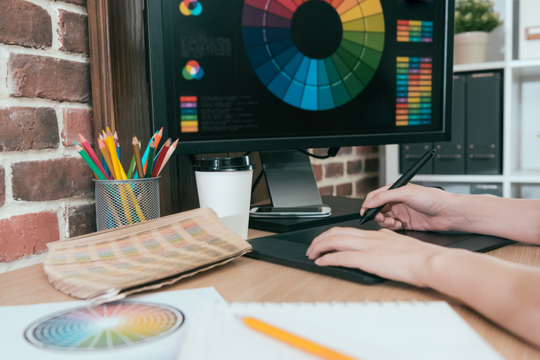Graphic designer, what does the job involve?
The role of a graphic designer is to create different visual content to communicate ideas and messages for various communication media. They use visual tools such as images, typography, and color to create designs that are attention-grabbing, effectively communicate, and aesthetically pleasing. They must be creative, able to understand the needs of clients and users, and use appropriate techniques to achieve communication objectives. He/she is responsible for creating designs for various communication media.
They must ensure that the designs created comply with the graphic standards and visual identity of the company for which they work. They are often involved in the design stages from the beginning of the project, developing visual concepts and ideas, then developing them using graphic tools and finally producing and distributing them. They must also be able to work closely with other departments within the company such as marketers, writers, web developers and project managers to ensure that the designs created meet the needs of the company and its clients.
Graphic designer, what are its main missions?
The main missions of a graphic designer in a company include:
- Understanding the needs of the company and its clients to create designs that meet their communication objectives.
- Create visual designs for various communication media such as brochures, catalogs, posters, advertising banners, packaging, logos, web banners, mobile applications and websites.
- Ensure that the designs created comply with the graphic standards and visual identity of the company.
- Work closely with other departments within the company to ensure that the designs created meet the needs of the company and its customers.
- Use graphic design software to create designs.
- Prepare files for production, prepare files for print or online distribution.
- Track design projects from concept phase to production.
- Conduct research to stay current on graphic design trends.
- Be able to present designs and concepts to clients and company team members.
It is essential to note that assignments may vary depending on the size of the company in which he/she works. Some of them may have specific requirements, so it is important that the graphic designer is flexible and able to adapt to the changing needs of the company.
Graphic designer, the different media used
A graphic designer can work on a variety of communication media. They may specialize in one or more types of media, depending on their training and experience. The most common media include:
- Printed media: brochures, catalogs, posters, magazines, books, packaging, business cards, flyers and brochures
- Digital media: websites, mobile applications, banner ads, web banners, emailing, video games, etc.
- Presentation media: PowerPoint presentations, slide shows, Keynote, etc.
- Signage: billboards, signs, tarpaulins, etc.
- Product supports: packaging, t-shirts, caps, pens, goodies, etc.
- Video supports: illustrations for motion design videos, title or transition screens
- Visual identity supports: logos, graphic guidelines, stationery, etc.
Graphic designer, the tools used
Graphic designers generally use a number of tools to create and edit visual designs. The most commonly used tools are:
- Graphic design software: Adobe Photoshop, Adobe Illustrator, Sketch and Inkscape. These programs allow you to create images, illustrations, typography and layouts for various communication media.
- Image editing software: Adobe Photoshop and Lightroom. These programs allow you to retouch and process images to make them more professional.
- Page layout software: Adobe InDesign and QuarkXPress. These programs allow you to lay out documents for printing, such as books, magazines,
brochures. - Web design software: Adobe XD, Figma and Sketch. These allow you to create designs for websites and mobile applications.
- Video and animation software: Adobe After Effects and Premiere Pro. These programs allow you to create animations and videos for digital media.
- Prototyping tools: Adobe XD, Figma and InVision. These tools allow you to create interactive mock-ups for websites and mobile applications.
Some graphic designers may use other tools depending on their specific needs. Some graphic designers are specialized in a particular field, such as illustration. While others have versatile profiles and can perform various services and use different tools. The goal is to meet the needs of the client and their projects.
In fact, the role of a graphic designer is to combine creativity, technical competence and the ability to understand the needs of the company and its users to create effective visual content that helps achieve the company’s communication objectives.
If you need to create design elements and communication materials for your company and you don’t have the time or the knowledge, don’t hesitate to contact us and use our services.

